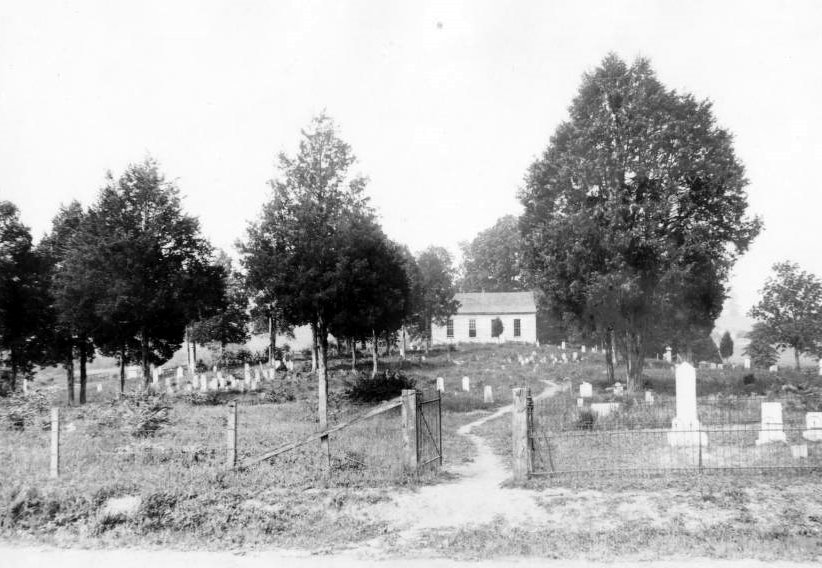“There’s a church in the valley by the wildwood, No lovelier spot in the dale.” These words from an old hymn always bring back memories of Concord Presbyterian Church in Old Concord, Tennessee. A look back at this old church, soon to be 225 years old, gives us a snapshot in time of the Concord Community and the people who lived there.
In 1796, the Rev. Samuel Graham Ramsey formed a church named Ebenezer Presbyterian and a preparatory school for men and girls named Ebenezer Academy. In 1798, the flourishing church decided to build a second “meeting place” on Concord Road. Since the two churches were of the same unified session, Ebeneezer church was named Upper Grassy Valley and the church on Concord Road was named Lower Grassy Valley. By 1833, the two congregations began to quarrel among themselves as to which church was receiving more time from the pastor at the pulpit; thus, the Presbytery accepted Lower Grassy Valley as a separate congregation and the church adopted the name Pleasant Forest Cumberland Presbyterian.

Concord Cumberland Presbyterian Church circa 1910, Second Drive, Concord, Tennessee
With a reported membership of 105, the young church soon outgrew the log cabin and by 1835 they were meeting in a new brick house said to be the first brick church erected in the county outside of Knoxville.
Other area churches were growing as well such as another church along Emory Road formed by Jeremiah and Cynthia Hardin Gambill. The name of that church was Concord Cumberland Presbyterian Church.
And so, it was fitting that when the East Tennessee, Virginia and Georgia Railroad laid down its tracks in Knox County in 1854, the depot was given the name of the nearest church and thusly named Concord Depot. From the railroad’s valuable contributions to the area, a newly platted town was formed, appropriately named Concord.
For some time, the congregation of Pleasant Forest had been experiencing a dissention in theology. Historians termed the two theologies “New School” and “Old School.” The church at Pleasant Forest maintained the old school theology and named their congregation Pleasant Forest North, while various members left the church to meet in homes to study by the new school theology calling their congregation Pleasant Forest South.
The dissention culminated with the Civil War. In 1863, Burnside’s troops dismantled the brick church at Pleasant Forest to use the bricks for chimneys in their cabins and for a period of time, no services were held at that location.
By 1871, Pleasant Forest North rebuilt a frame building on Concord Road. The Pleasant Forest South congregation was being allowed to use the Cumberland Presbyterian Church at the Masonic Lodge cemetery until they erected and built a new church at the corner of Clay and Second street naming it Concord Presbyterian Church in 1877.

Concord Presbyterian Church circa 1960
The railroad and marble industry soon made Concord the largest town in Knox County in 1887. The few remaining members of Pleasant Forest North were dismissed to unite with Concord Presbyterian in 1910.
Since that era, Concord Presbyterian has withstood the test of time and influx of new people to the community by adding new additions, a new manse, a fellowship hall, and other modifications as needed.
The years of the 1950s through 1970s bring golden memories to the author. Those were the days of Vacation Bible School, Kool-Aid and cookies, and barefoot friends. The members are examples of overcoming personal diversities, helping each other through war and stressful times, and coming together as a community. Truly no place is so dear to my childhood, as this church and the dear hearts and gentle people who lived and worshipped there.
I invite you to pick a beautiful fall day and visit this picturesque church. Sit on the steps, listen to the soft breeze and the chimes of the bell. Perhaps you will feel the spirit of those ancestors that have gone before you and find yourself refreshed with a new hope for future generations.
“A History of Concord Presbyterian Church” by Harry S. Hassall is recommended reading.
Effective with this article, Mona B. Smith is retiring from her post as author of Concord/Farragut stories for KnoxTNToday.com. She will be pursuing a compilation of her articles in a book in the near future.

